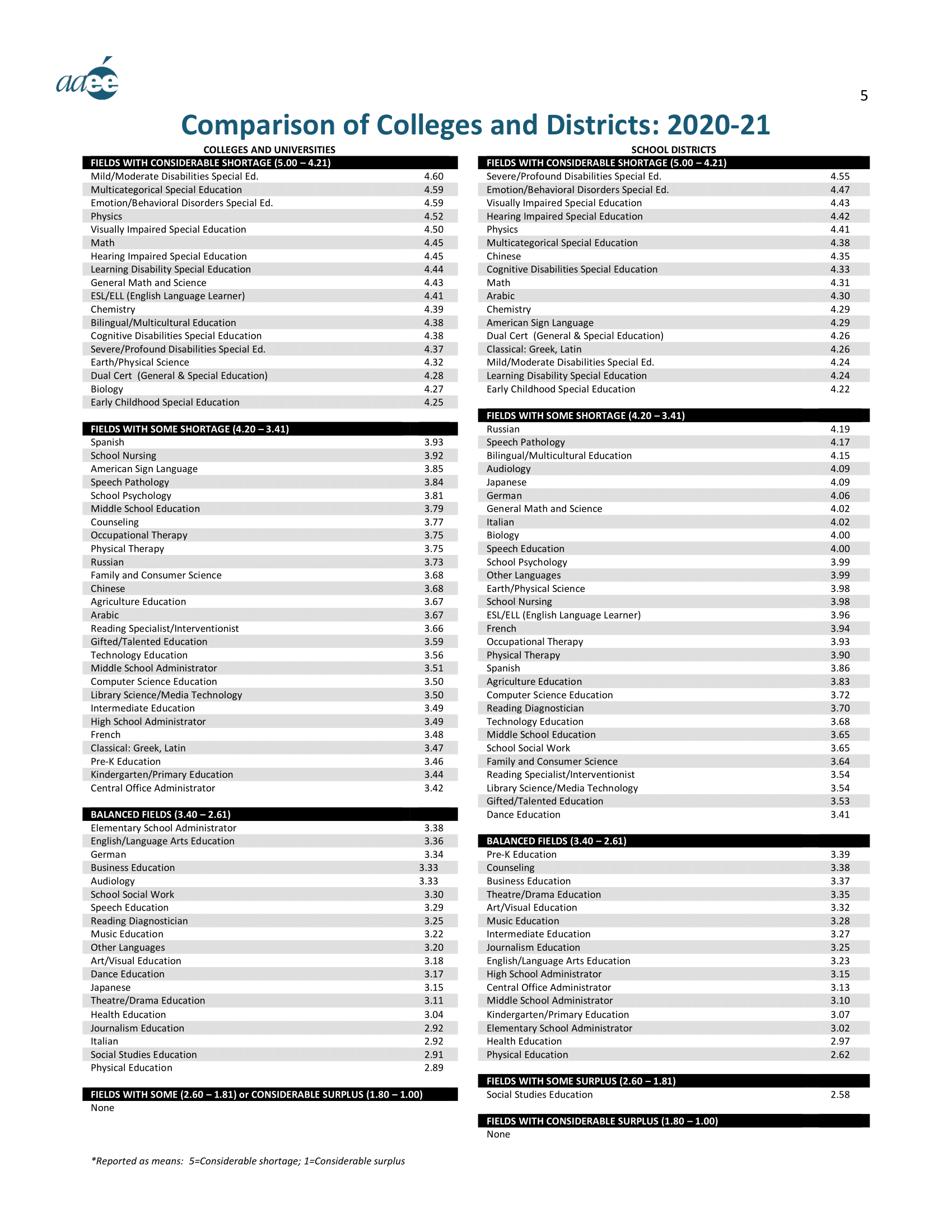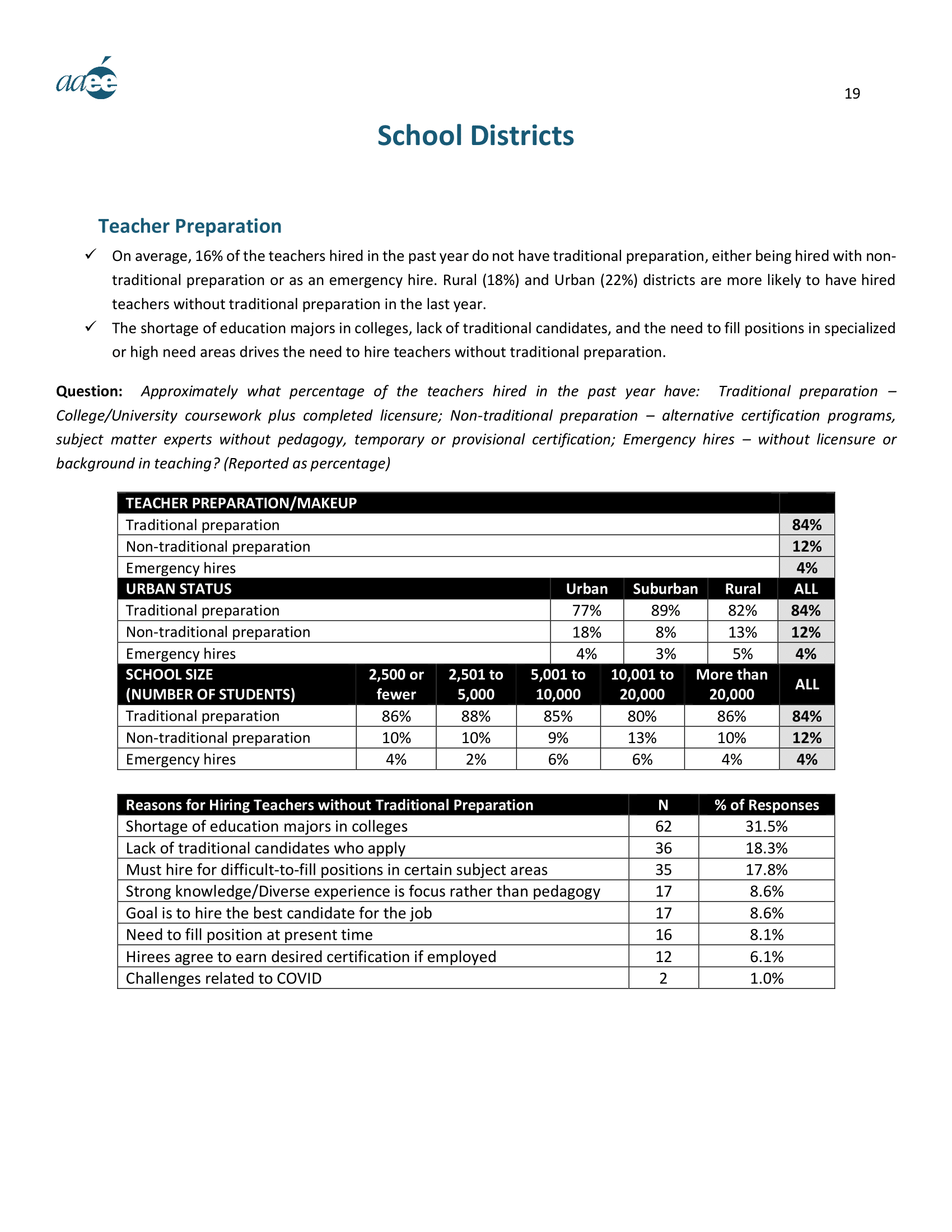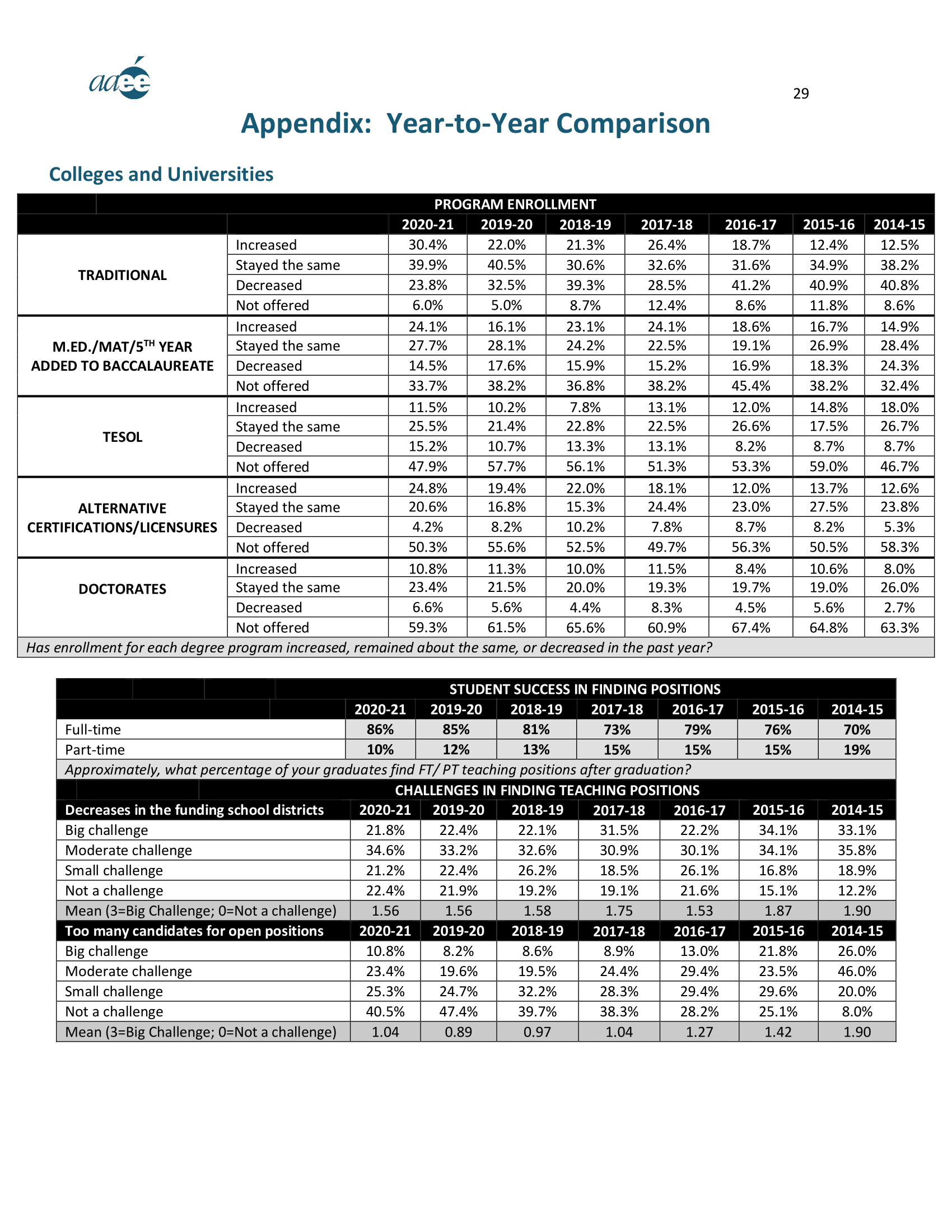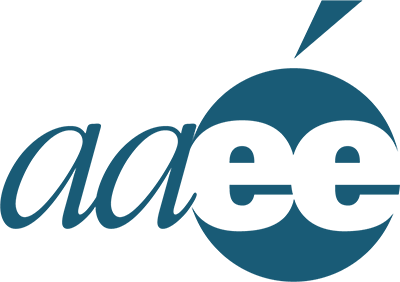AAEE Report Sheds Light on Shortages
Since schools reopened, educators have been doing their best to help students recover from interrupted learning caused by the pandemic and address the educational inequities brought to light. However, the efforts of many institutions have been severely hampered by a lack of teaching staff.
To find out more about the ongoing teacher shortages, the American Association for Employment in Education (AAEE) collected 466 surveys from school districts as well as colleges and universities between September 21, 2020 and March 31, 2021. The association’s resulting report, the 2020-2021 Educator Supply & Demand Survey shares several useful insights.
For example, almost two-thirds (60.5%) of the surveyed schools and districts reported that finding enough candidates to fill vacancies was a huge challenge. Another 27.9% found it to be a moderate challenge. This means that the vast majority (88.4%) of schools and districts had difficulties finding enough faculty during the 2020-21 school year.
The Impact on Learning
The survey found considerable teacher shortages in academic areas such as math, chemistry, physics, several languages, and the entire special education spectrum. Other academic fields, like earth/physical science, biology, computer science education, English as a Second Language (ESL)/English language learner (ELL) education, had teacher shortages to a lesser degree.

As you can see from the table, the academic areas mentioned above are not the only ones in need of teachers. Every unfilled staff vacancy means that schools are less able to provide students with a quality education. This applies to both core subjects, which give students a solid foundation for both academic and career success, and enrichment classes, which expand their skillsets and their understanding of the world. However, some academic areas are especially vital to students’ academic and future life success.
For example, non-English-speaking students must master complex academic words and phrases (such as the language used in science classes) to read their textbooks and participate in classroom discussions. Those students need the help of ELL teachers to acquire those technical terms and phrases. (Some ELL students can acquire conversational English on their own, but even then, their progress will be slower without the support of an ELL teacher.)
Additionally, ensuring that students with disabilities receive an equitable education requires the services of trained special education teachers. Many special education students will not be able to take advantage of learning opportunities without support from teachers with knowledge of medical and psychological issues.
Finally, the sciences and computer science have become so important to the U.S. economy that policymakers have made a special calls for STEM (science, technology, engineering and math) and computer science education. The National Science & Technology Council stated, “Individual success in the 21st century economy is … increasingly dependent on STEM literacy; simply to function as an informed consumer and citizen in a world of increasingly sophisticated technology requires the ability to use digital devices and STEM skills such as evidence-based reasoning.” The Bureau of Labor Statistics projects that computer occupations will make up two-thirds of all new STEM jobs created by 2029.
However, less than half of U.S. students are proficient or advanced in science, math, and technology and engineering literacy, according to the Nation’s Report Card. Teacher shortages in these areas will have future consequences for both students and the country.
Struggles with Non-traditional Preparation
Districts have been coping with teacher shortages by becoming less selective about certification. The AAEE survey found that on average, 16% of the teachers hired in the past year did not have traditional preparation and were either emergency hires or had non-traditional preparation. However, that practice maintains a chronic cycle of inequitable education by placing fewer experienced instructors in classrooms.
With traditional certification, teachers receive a four-year degree after going through student teaching experiences and courses in pedagogy, classroom management, specific content areas, and other topics. Non-traditional certification programs usually provide a faster path to classroom teaching, but that means most don’t prepare teachers as thoroughly as traditional programs.
Insufficiently prepared teachers are less likely to have the pedagogical knowledge needed to differentiate instruction and otherwise support struggling students. They also may be less adept at keeping students engaged in learning or checking for knowledge. Additionally, they’re more likely to be overwhelmed by the demands of teaching. These factors can disrupt students’ learning flow and sabotage their progress.
The AAEE survey found that urban schools had the highest percentage of teachers with non-traditional preparation hired in the past year (18% compared to 13% in rural schools and 8% in suburban schools). According to organizations such as the Pew Research Center, urban areas are now predominantly occupied by people of color. Consequently, the practice of hiring teachers with non-traditional training disproportionately impacts students of color.
But those schools are stuck for a teacher shortage solution. The survey found that almost a third (31.5%) of districts were hiring teachers who did not have traditional preparation because of a shortage of education majors in colleges. The other two most common reasons for this hiring practice were a lack of traditional candidates who apply for the position (18.3% of schools and districts) and the need to hire for difficult-to-fill positions in certain subject areas (17.8% of schools and districts).

The Situation is Set to Worsen
The teacher shortage could soon increase. According to the AAEE survey, 32.5% of schools and districts needed to hire more teachers because their existing faculty are leaving due to the COVID pandemic. Another 21.1% cited teachers retiring as the reason for their need to hire.
Those responses align with findings from other institutions. The 2021 State of the U.S. Teacher Survey from the RAND Corporation discovered that one in four teachers were considering leaving their job by the end of the 2020-21 school year. Similarly, Education Week reported that almost a third (32%) of National Education Association members had plans to leave the teaching profession earlier than they’d previously planned. Alarmingly, more than 25% of veteran teachers (those with 20+ years of experience) reported that they would be leaving earlier than originally planned. This means they will not be available to mentor less experienced colleagues or share their perspectives in professional learning communities.
One spot of good news is that the AAEE survey found fewer decreases in traditional education program enrollments than in years past. As far back as the 2014-15 school year, enrollments had been decreasing by 32.5%-41.2%. In the 2020-21 academic year, the decrease was only 23.8%. However, with more teachers set to leave the profession, even smaller declines in teacher education program enrollments will have an adverse impact on K-12 education.

Some academic areas will be hit harder than others by new shortages. The AAEE survey reports that education degrees with the lowest number of graduates for the 2020-21 school year include computer science education, journalism education, most languages, and physics.
Virtual instruction as a Solution
Virtual instructors can help schools and districts overcome their hiring challenges. For example, almost a quarter (21.8%) of survey respondents cited their undesirable location/demographics as a reason for their having difficulty hiring teachers. Rural and urban areas generally tend to be the locales that prospective teachers view as undesirable, and the AAEE survey did indeed find that rural (18%) and urban (22%) districts were more likely to have hired non-traditionally prepared teachers in the past year.
A 2018 study from the University of Pennsylvania’s Graduate School of Education shared further insights into the difficulties such schools face. It stated that “high-poverty, high-minority, urban, and rural public schools have among the highest rates of turnover,” experiencing “an annual asymmetric reshuffling of significant numbers of employed teachers from poor to not-poor schools, from high-minority to low-minority schools, and from urban to suburban schools.”
Virtual instruction can help those schools provide educational equity by placing teachers in their classrooms without requiring the teachers to physically commute to or live in the locates. Because geographical distance is not a concern, one virtual teacher can provide services to several schools and districts, teaching a class in a rural school in Montana at 10:00 a.m., another class in Newark, New Jersey at 1:00 p.m., and yet another class in Texas at 3:00 p.m.
Finances also play a huge part in districts’ hiring challenges. More than three-quarters (77%) of K-12 respondents said decreased district funding posed a big to moderate challenge to their hiring. Plus, a little more than one in five (20.9%) of schools and districts said that offers of low compensation/ benefits undermined hiring efforts. If virtual instructors are supplied by a third-party provider, that organization will handle the matter of salary and benefits. Districts can use Elementary and Secondary School Emergency Relief (ESSER) funds to partner with a provider or hire their own virtual instructor. And as mentioned above, several districts can share a virtual instructor, which means they also share the financial onus of filling teacher vacancies.
Virtual instruction can even help districts with challenges such as ELL students and special needs students. Both these student populations benefit from the visual learning (videos, diagrams, and more) component of video-sharing, which bolsters their comprehension and engages them in learning. Additionally, virtual special education teachers can revise student IEPs, arrange meetings with parents, and provide the state DOE with updates.
The AAEE report also revealed that schools with more than 20,000 students had the most difficulties filling teacher vacancies. Those schools can use live virtual teachers to address the problems discussed above as well as to fulfill other needs (e.g., substitute teachers, enrichment classes, etc.).
What to Look For
The two main attributes to look for in a virtual teacher is state certification and training in online instruction and technology. Trained live virtual teachers have mastered techniques for engaging students online (e.g., gamification) as well as measuring learning progress (e.g., spiraling and repetition). These teachers also have a repertoire of virtual tools for accomplishing these tasks (e.g., grading functions embedded in educational gaming programs, MobyMax curriculum, TicTacToe Hyperdocs, etc.)
One resource is the National Virtual Teacher Association, which puts teachers through a certification course to ensure they are highly proficient in online instruction and requires that the certification be renewed every two years to ensure teachers stay cognizant of changes in technology and practices. The association also provides rubrics so that administrators and third party providers can evaluate whether teachers are delivering quality instruction
It’s best to look for teachers who deliver online instruction synchronously (via live interactions). One of the benefits of synchronous instruction is that teachers can respond to student questions and needs as they arise, so there’s less chance of students becoming frustrated or losing interest. Another is that teachers can virtually guide students through hands-on activities. These real-time interactions not only help with comprehension and retention of information but also significantly increase student engagement.
Proximity Learning Can Help
Proximity Learning’s mission is to connect students with the expert teachers they deserve and deliver all the benefits of virtual instruction previously mentioned. Our proprietary Enriched Live Instruction Model (ELIM) creates equitable learning environments in school districts through live-streamed teaching. Over the years, we’ve refined our ELIM approach to the point that our teachers deliver instruction for electives like physical education, choir, culinary arts, business, and engineering just as effectively as for core subjects.
In addition to being state certified, our teachers are background checked and are extensively trained in our ELIM. The teachers who choose to work with us are committed to excellence and continuously seek out the best digital tools for delivering quality education to be a teacher shortage solution.
The efficacy of our approach was confirmed by a 2020 study by Chicago State University. After analyzing the grades of 30,524 participants in 983 random student courses, it found that Proximity Learning students’ percentage mean was 80.34% out of 100% (a B grade on the traditional scale) over six terms. That meant our students scored an average of 6% higher than the national average of 74.4%. Districts’ increasing confidence in us is a further testimonial to our quality, student-first approach. We’ve grown from five teachers instructing about 1,000 students in 2009 to over 800 teachers serving almost 100,000 students every day.
Conclusion
Since early 2020, schools and districts have been facing new challenges that have exacerbated yearslong educational inequities. Students in many urban and rural communities desperately deserve access to quality education so that they can create a better future for themselves and their families. Technological advances make it possible to deliver virtual instruction for practically every area of learning and bring educational equity to students, no matter where they live.






